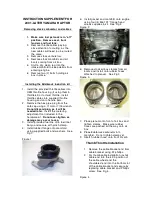
The seat belts are designed to protect you in many types
of collisions. The front airbags deploy only in moderate
to severe front collisions. In certain types of collisions,
both the front and side airbags may be triggered. But
even in collisions where the airbags work, you need the
seat belts to keep you in the right position for the airbags
to protect you properly.
Here are some simple steps you can take to minimize
the risk of harm from a deploying airbag.
1. Infants in rear-facing child safety seats should
NEVER
ride in the front seat of a vehicle with a passenger frontal
airbag unless the airbag is shut OFF. See “Passenger
Airbag On/Off Switch” and “To Shut Off the Passenger
Airbag.” The rear-facing seat places them too close to the
passenger air bag in the event of a crash. An airbag
deployment can cause severe injury or death to infants in
this position.
Children that are not big enough to properly wear the
vehicle seat belt (see section on “Child Restraint”) should
be secured in child safety seats or booster seats that are
appropriate for the child’s age, height, and weight.
Older children who do not use child safety seats or
booster seats should ride properly buckled. Never allow
children to place the shoulder belt behind them or under
the arm.
If a child from 1 to 12 years old must ride in the vehicle,
move the seat as far back as possible, shut off the
passenger airbag, and use the proper child restraint. See
the section on “Child Restraint.”
You should read the instructions provided with your
child restraint or belt-positioning booster seat to make
sure that you are using it properly.
2. All occupants should wear their lap and shoulder belts
properly.
3. The driver and passenger seats should be moved back
as far as practical to allow the front airbags room to
inflate.
4. Do not lean against the door, as the side airbags will
inflate forcefully into the space between you and the
door. (See the section on “Side Airbags.”)
30
THINGS TO KNOW BEFORE STARTING YOUR VEHICLE
Summary of Contents for Crossfire SRT6
Page 2: ......
Page 5: ...INTRODUCTION 5 1 ...
Page 96: ...INSTRUMENTS AND CONTROLS 96 UNDERSTANDING YOUR INSTRUMENT PANEL ...
Page 164: ......
Page 188: ......
Page 191: ...3 2L SRT ENGINE MAINTAINING YOUR VEHICLE 191 7 ...
Page 253: ...IF YOU NEED CONSUMER ASSISTANCE 253 9 ...
Page 263: ...IF YOU NEED CONSUMER ASSISTANCE 263 9 ...
Page 265: ...INDEX 10 ...
Page 274: ...NOTES ...
Page 275: ...NOTES ...
Page 276: ...NOTES ...
Page 277: ...NOTES ...
Page 278: ...NOTES ...
Page 279: ...NOTES ...
Page 280: ...NOTES ...
















































